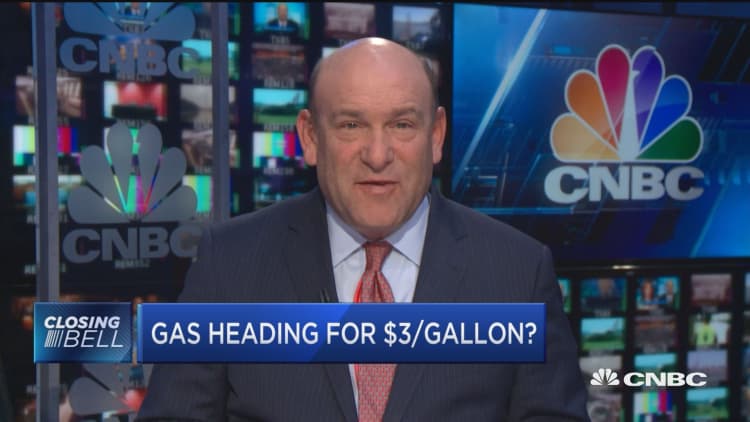Buckle up, America. Gas prices have a hit a level not seen in three years and are expected to continue their upward trajectory.
The national average for a gallon of gas reached $2.82 this week, a level not seen since summer 2015, according to online gas station database GasBuddy.com.
Californians are paying the most: $3.61 per gallon. By contrast, Oklahoma has the lowest state average, at about $2.50.
While gas prices typically head higher every spring due to increased driving demand, the current average is 48 cents more per gallon — an increase of about 20.5 percent — than the $2.34 consumers paid a year ago before prices inched downward. For most of summer 2017, the average price hovered around $2.30 or trended lower.
The summer months will likely bring even higher prices.
"While it won't cost motorists as much as it did during 2011 to 2014 [when national averages ran $3 to $4], it will cost them millions more every day versus last year," said Patrick DeHaan, senior petroleum analyst for GasBuddy.com.
If the higher prices pinch your budget or affect your vacation plans, there are ways to save money on gas.
For starters, shop around.
Depending on where you live, there can be big price swings between gas stations. For instance, a recent review of the Los Angeles area found a difference of about $1 per gallon between the highest- and lowest-price stations, DeHaan said.
While the difference in price per gallon may only be a few pennies, it still adds up.
"Even if it's a difference of a nickel or dime, that could become a couple hundred dollars in savings," DeHaan said.

Also, if you cross state lines in your driving, be aware that there can be stark differences in average prices from one state to the next, in part due to varying gas taxes.
"Sometimes the difference can be 40 cents or even 80 cents a gallon," DeHaan said.
Additionally, if you can plan ahead by using an app to find the best prices along your route, do it, DeHaan said. Some gas stations also offer discounts if you pay with cash.
AAA offers these tips for saving on gas as you drive:
- Slow down. The faster you drive, the more fuel you use. Every 5 miles per hour over 50 mph is like paying an additional 18 cents per gallon, according to the Department of Energy.
- Share work or school rides by carpooling, or consider public transportation.
- Do not use your trunk for long-term storage. The heavier your car, the more fuel it uses.
- Combine errands. If possible, park in a central spot and walk from place to place.
More from Personal Finance:
3 ways to get other people to pay off your student loans
Meghan Markle could be in for a wedding gift she doesn't want: A bigger tax bill
How to join the ranks of money-savvy independent workers


